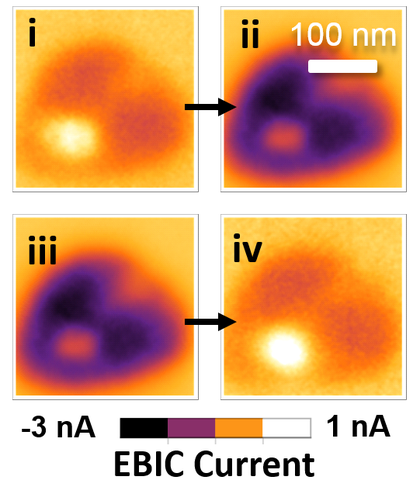Summary
Neuromorphic computing is a radical new approach to information processing for artificial intelligence where, instead of using digital electronics, inspiration is taken from the brain to develop entirely new electronic circuits and architectures. In order to mimic brain activity in the most energy efficient way, it is advantageous to introduce new electronic devices that model directly neurological elements like synapses and neurons. Many if not all of these new devices – which take many forms – are in early stages of development and so require measurement and characterization to elucidate the underlying processes that produce their behavior. We are conducting such measurements on a number of interesting systems.
Description

EBIC image of an on (i) to off (ii) and off(iii) to on (iv) transition in a TiOx memristor.
One type of device that is emerging as an attractive artificial synapse is the resistive switch, or memristor. These devices, which usually consist of a thin layer of oxide between two electrodes, have conductivity that depends on their history of applied voltage, and thus have highly nonlinear, hysteretic I-V curves. The underlying mechanisms that cause this behavior are not well understood, but are largely thought to be related to the formation of a nanoscale filament of vacancies or other dopants.
We are developing measurement tools to investigate the switching processes in memristors based on a range of imaging tools. For example, we use electron-beam induced current (EBIC) in a field-emission scanning electron microscope (FESEM) to obtain high resolution images of switching filaments, and also explore the origin of the conductivity as a function of memristor state by varying the impact energy, which allows us to probe the depth dependence of the EBIC current. We are also employing scanning thermal microscopy to image the local heat distribution in actively switched devices to elucidate the filament formation process.
Another device with potentially useful functionality for neuromorphic computing is the magnetic tunnel junction. These devices are already being incorporated into integrated circuits to provide non-volatile memory. A straight-forward application is then to use them to store synaptic weights locally, removing the energy cost of transferring them from remote memory. However, using the same device stack but varying the geometry allows these devices to become compact oscillators to become stochastic superparamagnetic devices. Building on our expertise in spintronics, we are developing ways to couple these devices and to characterize their coupled behavior.

